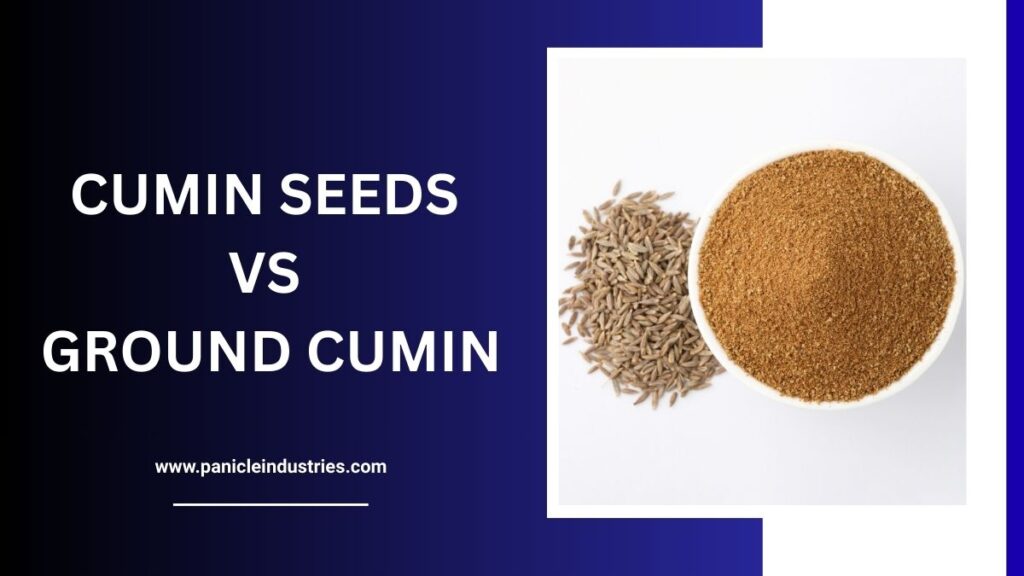Cumin is one of the most widely used spices in kitchens around the world. Whether you are preparing an Indian curry, a Mexican taco, or a Middle Eastern stew, cumin adds a rich, earthy flavor that enhances the taste of any dish. But when shopping or cooking, many people wonder about the difference between cumin seeds vs ground cumin. Are they the same? Can you use one in place of the other? These are common questions, especially for those new to cooking or trying out new recipes.
In this blog, we will explain the key differences between cumin seeds vs ground cumin, their uses in cooking, flavor profiles, storage tips, and how to choose the right one for your recipe.
What Are Cumin Seeds?
Cumin seeds are the dried seeds of the Cuminum cyminum plant, a member of the parsley family. These small, elongated brownish seeds are packed with flavor and aroma.
Key Features of Cumin Seeds:
- Whole form of the spice
- Light to dark brown in color
- Warm, earthy, and slightly nutty flavor
- Used in whole or dry-roasted form in cooking
Common Uses:
- Added to hot oil at the beginning of cooking
- Used in Indian tadka (tempering)
- Found in spice blends like garam masala and curry powder
- Used in soups, rice dishes, and pickles
Also read: Is Parsley and Coriander the Same?
What Is Ground Cumin?
Ground cumin is simply cumin seeds that have been finely powdered. It is convenient, easy to use, and blends well with other spices.
Key Features of Ground Cumin:
- Powdered form of the cumin seed
- Pale to dark brown in color
- Stronger and more concentrated in flavor
- Adds depth to sauces, marinades, and spice rubs
Common Uses:
- Used in spice blends like taco seasoning
- Added to curries, stews, and soups
- Used in dry rubs for grilled meats
- Perfect for marinades and salad dressings
Cumin Seeds vs Ground Cumin: Key Differences
Let’s break down the main differences between cumin seeds vs ground cumin in a simple table:
| Feature | Cumin Seeds | Ground Cumin |
|---|---|---|
| Form | Whole seeds | Finely powdered spice |
| Flavor | Milder, nutty, slightly smoky | Stronger, more concentrated |
| Usage | Best for tempering and roasting | Ideal for blending in sauces |
| Aroma | Light and warm | Deep and intense |
| Shelf Life | Longer (up to 1 year or more) | Shorter (6–8 months) |
Both are made from the same spice, but their different forms affect how they are used and how they taste in dishes.
Flavor and Aroma: How They Compare
The flavor of cumin depends heavily on its form and how it is used.
Cumin Seeds:
- Have a milder flavor when added whole
- Roasting enhances their nutty, earthy notes
- Provide a subtle crunch and burst of flavor when bitten
Ground Cumin:
- Has a more intense aroma
- Spreads quickly through the dish
- Offers immediate flavor impact
In recipes where a deeper infusion of cumin is needed, ground cumin is preferred. In recipes that begin with tempering or frying, whole seeds are the better choice.
When to Use Cumin Seeds
Use cumin seeds when you want to build a flavor base in your dish or add a crunchy, aromatic layer. They are usually added to hot oil at the beginning of cooking, especially in Indian and Middle Eastern cuisines.
Best Dishes for Cumin Seeds:
- Indian dals and curries
- Vegetable stir-fries
- Rice dishes like jeera rice
- Lentil soups
- Pickles and chutneys
Roasting cumin seeds before adding them to a dish brings out their strong aroma and enhances the taste significantly.
When to Use Ground Cumin
Ground cumin works best when you want to blend the flavor into the dish or when there is no opportunity to temper seeds. It is easy to mix and gives even flavor distribution.
Best Dishes for Ground Cumin:
- Spice rubs for grilled chicken or lamb
- Mexican tacos and chili
- Curry sauces and gravies
- Stews and marinades
- Hummus and yogurt dips
Ground cumin is ideal for adding depth and complexity to your dish quickly and easily.
Can You Substitute Cumin Seeds with Ground Cumin?
Yes, you can substitute one for the other, but there are some important points to keep in mind:
Substituting Ground Cumin for Cumin Seeds:
- Use half the amount, as ground cumin is more concentrated
- Best added later in the cooking process
Substituting Cumin Seeds for Ground Cumin:
- Use twice the amount of cumin seeds
- Toast or fry them first to bring out their flavor
Always remember to adjust the quantity to avoid overpowering the dish.
Health Benefits of Cumin
Cumin is not only flavorful—it is also packed with health benefits. Whether you use seeds or ground form, cumin is a healthy addition to your diet.
Key Health Benefits:
- Aids digestion and reduces bloating
- Improves immunity with its antioxidant content
- Regulates blood sugar levels
- Promotes weight loss when used regularly
- Rich in iron, especially useful for vegetarians
Both cumin seeds and ground cumin offer these benefits, but whole seeds may have a slightly higher oil content, offering better digestive benefits.
How to Store Cumin
Proper storage will help retain flavor and aroma for a longer time.
Storing Cumin Seeds:
- Keep in an airtight container
- Store in a cool, dry place, away from light
- Shelf life: 12–18 months
Storing Ground Cumin:
- Keep tightly sealed
- Best used within 6–8 months
- Avoid moisture and heat
For best results, buy cumin seeds and grind them fresh as needed to preserve the oils and aroma.
Cumin in Global Cuisines
Cumin is used in a wide variety of cuisines around the world.
In Indian Cuisine:
- Essential in dals, curries, and masalas
- Jeera rice and chaas (spiced buttermilk)
In Middle Eastern Cuisine:
- Flavoring for kebabs and rice dishes
- Added to hummus and falafel
In Mexican Cuisine:
- Used in taco seasoning
- Key in chili and enchiladas
In North African Cuisine:
- Common in tagines and spice blends like Ras el Hanout
Whether whole or ground, cumin adds a signature warmth that is hard to replace.
Tips for Cooking with Cumin
- Always toast cumin seeds before use to enhance their flavor
- Add ground cumin in the middle or end of cooking for best aroma
- Store cumin in small batches to retain freshness
- Mix cumin with other spices like coriander, chili, and turmeric for well-balanced flavors
Conclusion
To summarize, cumin seeds vs ground cumin is not just a matter of form—it’s about flavor, use, and cooking style. Cumin seeds offer a milder, nuttier taste and are great for tempering dishes at the start of cooking. Ground cumin provides stronger, more immediate flavor and is perfect for sauces, marinades, and spice blends. Both come from the same plant but have different roles in the kitchen.
Knowing when and how to use each form can improve the taste and aroma of your dishes significantly. So the next time you reach for cumin, choose wisely depending on what your recipe calls for—and enjoy the rich, earthy warmth it brings to your food.


